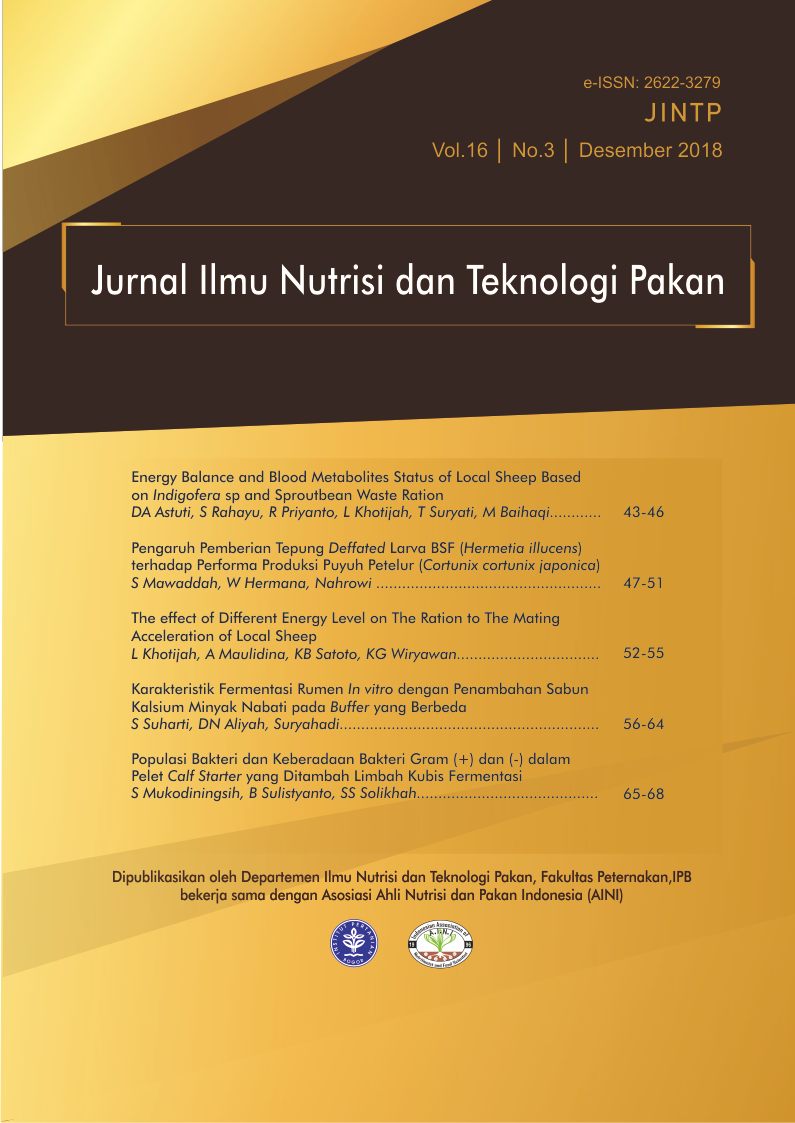Populasi Bakteri dan Keberadaan Bakteri gram (+) dan (-) dalam Pellet Calf Starter yang Ditambah Limbah Kubis Fermentasi
DOI:
https://doi.org/10.29244/jintp.16.3.65-68Abstract
The aim of the experiment was to evaluate total bacteria population and the existence of positive and negative gram bacteria of pellet calf starter which added by lactic acid bacteria from fermented cabbage waste. The materials in this research were corn, rice bran, soybean meal, mineral mix, molasses, fermented cabbage wasted. The research was conducted by Completely Randomized Design with 4 treatments and 5 replications. The treatments were T0 (100% calf starter), T1 (2% of fermented cabbage waste + 100% calf starter), T2 (4% of fermented cabbage waste + 100% calf starter) and T3 (6% of fermented cabbage waste + 100% calf starter). The Variables observed were bacteria population and gram bacteria. Data of bacteria population were evaluated by descriptive analysis, while data of gram bacteria existence were statistically analyses by variance analysis, if there were significantly affect continued by Duncan test. The results showed that the highest bacteria population was on the treatment with addition level 2% of fermented cabbage waste and the lowest bacteria population was on addition level 6%. Adding fermented cabbage waste did not significantly effect to the existence of gram bacteria. The average score of gram bacteria existence on added fermented cabbage waste from level 0%, 2%, 4%, and 6% were respectively 1.99; 2.10; 2.29 and 2.29. Positive gram bacteria extended increased with increased fermented cabbage waste. The conclusion was the pellet calf starter which added with lactic acid bacteria produced bacteria and there was positive gram bacteria, and suppress negative bacteria.
Keyword: bacteria population, fermented cabbage waste, gram bacteria, pellet calf starter
Downloads
References
Astawan M, Wresdiyati T, Arief II & Suhesti E. 2011. Gambaran hematologi Tikus Putih (Rattus norvegicus) yang diinfeksi Escherichia coli enteropatogenik dan diberikan probiotik. Med. Pet. 34 (1): 7–13
Belanche A, Abecia L, Holtrop G, Guada JA, Castrillo C, de la Fuente G & Balcells J. 2011. Study of the effect of presence or absence of protozoa on rumen fermentation and microbial protein contribution to the chyme. J. of Anim. Sci. 89 (12) : 4163-4174
Fardiaz S. 1992. Mikrobiologi Pangan 1. Jakarta (ID): PT Gramedia Pustaka Utama.
Faridz R, Hafluddin & Anshari M. 2007. Analisis jumlah bakteri dan keberadaan Escherichia coli pada pengolahan ikan teri nasi di PT. Kelola Mina Laut unit Sumenep. Embryo. 4 (2): 94–106.
Mukodiningsih S, Budhi SPS, Agus A & Ohh SJ. 2010. Effect of molasses addition level to the mixture of calf starter and corn fodder on pellet quality, rumen development and performance of Holstein – Friesian calves in Indonesia. J. of Anim. Sci. and Tech. 52 (3) : 229 – 236
Mukodiningsih S, Achmadi J, Wahyono F, Utama CS, Putri ON, Solikhah SS1 & Ohh SJ. 2017. Handling and using waste Cabbage as feed additive on pellet of calf starter and It’s effect to microbiology quality. Advanced Science Letters. 23(3): 2589-2590
Poeloengan M. 2014. Pengujian yoghurt probiotik pada pertumbuhan bakteri. JITV. 303–307.
Steel RGD & JH Torrie. 1981. Principle and Procedures of Statistic. 2nd. New York: McGraw-Hill International Book Company.
Sukmadinata NS. 2011. Metode Penelitian Pendidikan. Bandung: PT Remana Rosdakarya.
Wudu T, Kelay B, Mekonnen HM & Tesfu K. 2008. Calf morbidity and mortality in small holder dairy farm in Ada`a Liben district of Oromia, Ethiophia. Trop. Anim. Health Prod. 40 (5): 369-376
Downloads
Published
Issue
Section
License
The authors of the submitted manuscript have to understand and agree that the copyrights published are held by Jurnal Ilmu Nutrisi dan Teknologi Pakan. Copyrights includes rights in reproducing, distributing and selling every section of articles in all forms and media. The copyright transfer form is signed by the corresponding author. The author”
• Creative Commons Attribution (CC BY)
you are allowed to:
Share – copy and redistribute the material in any medium or format
Adapt – remix, transform, and build upon the material
for any purpose, even commercially.
The licensor cannot revoke these freedoms as long as you follow the license terms.
Jurnal Ilmu Nutrisi dan Teknologi Pakan (Nutrition and Feed Technology Journal)

This work is licensed under a Creative Commons Attribution 4.0 International License.


